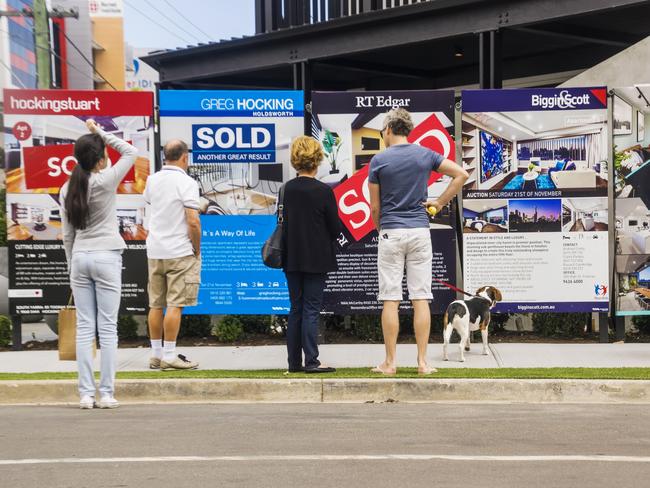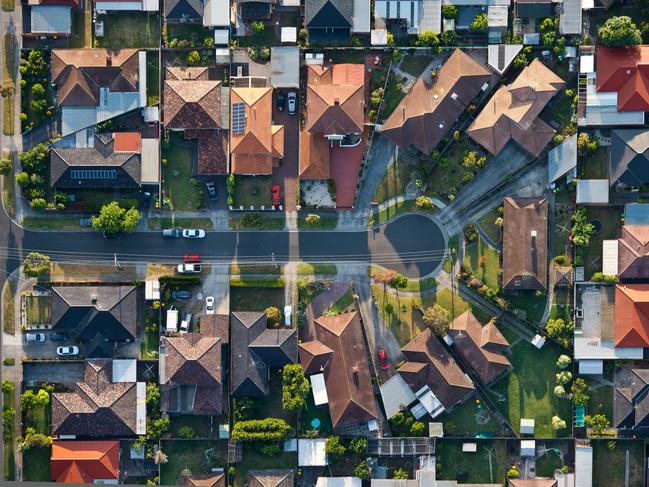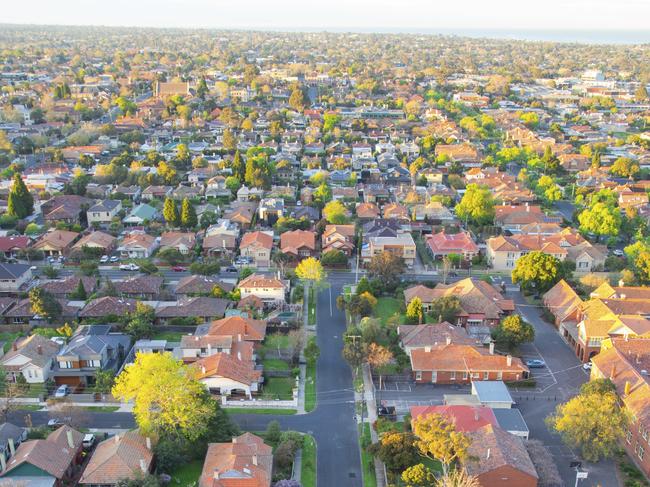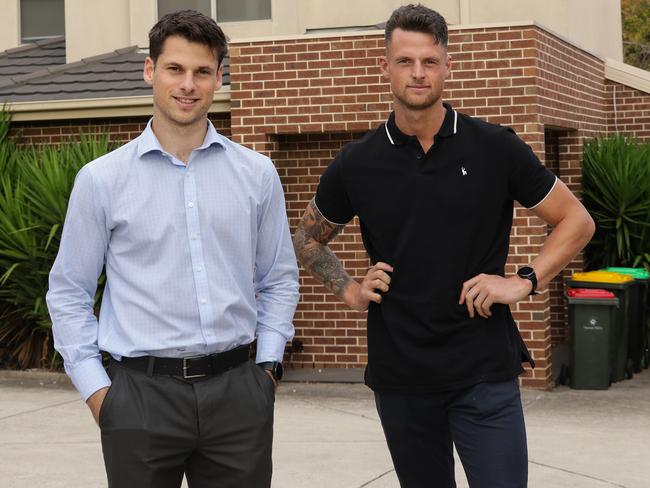Moderate income families are being ‘locked out’ of established suburbs, which is pushing more people to outer suburbs
The Andrews government is being urged to scrap stamp duty and encourage more affordable medium density housing in established areas.
Victoria
Don't miss out on the headlines from Victoria. Followed categories will be added to My News.
Stamp duty should be axed to give moderate income home buyers more options and limit Melbourne’s outer suburban sprawl, a landmark new report says.
And government subsidies such as first home buyers grants should be replaced by schemes that encourage more affordable medium density housing built in established areas.
Infrastructure Victoria will on Tuesday release a blueprint for coping with soaring population, which it says will see an average of one million extra people a decade added to Melbourne in the next 30 years.
Ten recommendations provided to the state government include tax and grant reforms, better townhouse standards to fast track medium density developments, changes to developer infrastructure charges, and slashing red tape for building dual occupancy homes.

Infrastructure Victoria chief executive Dr Jonathan Spear said moderate income families were being “locked out” of established suburbs, which was pushing more people to outer suburbs where it is four times more expensive to build infrastructure.
Growth areas have long been a challenge for the government, with young families increasingly frustrated about poor access to hospitals, education and transport.
Stamp duty reform options include the potential to shift to an annual land tax charge, rather than an expensive lump sum, which would promote mobility among home buyers.
“People buy bigger homes than they need because they don’t want to pay the stamp duty more than once,” Dr Spear said.
“That means that they’re buying homes in the greenfields further out than they need to, earlier.”

The ACT and NSW have recently introduced reforms to phase out stamp duty, in moves also aimed at encouraging downsizing, or helping people shift closer to jobs.
One option would be to allow home buyers to choose either stamp duty or an annual tax in the short term, before phasing out the lump sum option over time.
In Melbourne, the median price of a house is about $920,000, which slugs buyers with stamp duty costs of about $50,000.
For a property costing $1.5m, the tax grab soars to $82,500.
Dr Spear also took aim at stamp duty concessions, which has seen the threshold for discounts move towards average prices in growth areas; while he said first homebuyer grants are effectively pocketed by developers by being passed through to property prices.
To make its recommendations, Infrastructure Victoria surveyed 6000 people in Melbourne, Geelong and Ballarat – the largest of its type – to ask what households with annual incomes of between $88,000 and $132,000 actually want.
While most were happy to shift to the edges of cities if they could get a bigger block, one in five of those surveyed say they would trade off size for better connected areas if there were affordable three bedroom options available.
The report shows “precincts” under development, such as around the Suburban Rail Loop stations, Fisherman’s Bend, Arden and Sunshine, were “a good start” to adding more population to established areas but “it’s just nowhere near enough to accommodate all of our growing population”.
It also shows the government was nowhere near its long-term aim of 70 per cent of new homes being built in established areas – currently sitting at 44 per cent and getting worse.
“We’re going to have roughly a million more people come to Melbourne every decade for the next three decades. This is an issue that’s not going to go away,” Dr Spear said.
Councils should also get incentives for meeting new housing targets, which would be reported transparently and encourage 3-bedroom properties, while strict car park limits should be eased for apartments near transport links.
What homebuyers really want
Despite claims the Australian Dream is dead, the typical Victorian is still overwhelmingly clinging to the hope of owning a three-bedroom house that can support their family.
That’s the key message from Infrastructure Victoria’s research into housing, which used a survey of more than 6000 households – the biggest of its kind in Australian history – to develop its findings.
Through the extensive polling and 22 focus groups, the body aimed to better understand the mind of Victorian homebuyers so that it could find policies encouraging those on middle incomes to consider already-developed suburbs.
It found 62.2 per cent of those surveyed would want a three-bedroom house if they had to move in Melbourne, Geelong or Ballarat at current prices.
The majority of these people suggested they would live in the outer suburbs, growth areas or the regions to do so.
“Many people we spoke to share a similar vision of their ideal home – a detached three-bedroom house in an established suburb, close to family and friends,” Infrastructure Victoria’s housing report says.

“But this ideal is well out of reach for moderate income households in most Melbourne suburbs. People’s preference for a large, detached home combined with household budget constraints is driving demand for homes in Victoria’s new-growth suburbs, or greenfield areas, where the median household income among new homebuyers is just over $90,000.”
An overwhelming majority of Victorians also told Infrastructure Victoria they would continue to choose growth suburbs even if built-up areas were cheaper and these areas would continue to be vital for the state’s population growth.
“However, we found that one in five would trade house and land size to live in an established suburb in a medium-density home, such as an apartment or townhouse, if it was available at a more comparable price,” the report said.
“These are the buyers and renters the Victorian government must provide more choices for if it wants to rebalance the distribution of new homes between existing suburbs and new-growth areas.”
The research found two-thirds of people favoured detached houses if they were to move, compared to 18 per cent for apartments and 14 per cent for townhouses. Families had concerns about apartments, including noise, space to play and parking.
“These results indicate that well-designed, larger apartments can be an alternative to greenfield homes in some instances,” the report said.
“Children and their parents can benefit from living in established suburbs that offer better access to infrastructure such as schools, childcare and public transport, but few alternatives to greenfield homes are built that meet their needs.”
Teaming up to get into the housing market
Brothers Jack and Daniel Mighell pooled their savings to buy their first home in Melbourne’s northwest, but the price of their property meant they weren’t eligible for any “first homebuyer” help.
Buying an established home in Airport West rather than a new development in the outer suburbs meant they were not eligible for a first homebuyer’s grant to help ease the financial load.

And because their three-bedroom townhouse cost more than $750,000, they weren’t eligible for any stamp duty discounts either.
Jack, 27, said the proximity to the city and public transport outweighed buying a larger house in the outer suburbs.
“We wanted to buy in Airport West because we grew up in this community, so we didn’t want to buy too far from that,” Jack said.
“I also work in the city and Airport West is a pretty good spot in terms of public transport to and from work.”
Jack said introducing incentives for first home buyers looking to buy in middle Melbourne and the inner city would make it easier for people trying to buy their first home.
“I think that would definitely help, particularly for people like us, where it’s not too practical to move too far out of the city and who want to try to stay in that local community they grew up in,” he said.
“It would definitely help to have some kind of assistance.
“I think the only way we managed to get into the housing market is because we teamed up together.
“I think some assistance to help people buy in the inner city or inner suburbs of Melbourne would be a good idea.”
Daniel, 28, said even after years of saving and combining their assets, the brothers were still forced to borrow from “the bank of mum and dad” to buy their first home.
“We saved pretty hard to get the deposit down and pay the home loan repayments ourselves, but we got a little kick there just to get us into the market,” Daniel said.
He said they struggled to find an inner-suburbs property their matched their interests within their price range.




